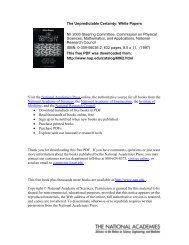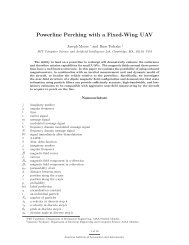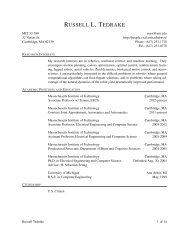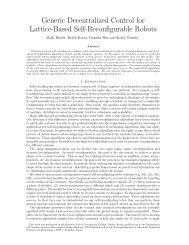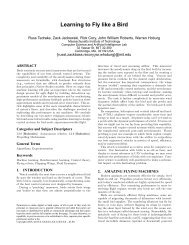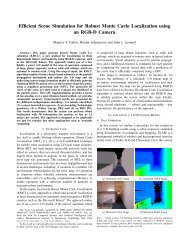Color CIE-Lab (a.k.a. CIE L*a*b*) Hue Saturation Value - CSAIL - MIT
Color CIE-Lab (a.k.a. CIE L*a*b*) Hue Saturation Value - CSAIL - MIT
Color CIE-Lab (a.k.a. CIE L*a*b*) Hue Saturation Value - CSAIL - MIT
Create successful ePaper yourself
Turn your PDF publications into a flip-book with our unique Google optimized e-Paper software.
<strong>Color</strong><br />
<strong>Color</strong> Vision 1<br />
Review of color<br />
• Spectrum<br />
• Cone sensitivity function<br />
• Metamers<br />
– same color, different spectrum<br />
• Opponent<br />
– black-white, blue-yellow, red-green<br />
• <strong>Color</strong> spaces<br />
– Linear algebra<br />
– Problem with negative values<br />
– Standard: <strong>CIE</strong> XYZ<br />
• Perceptually uniform color space<br />
– <strong>CIE</strong> <strong>Lab</strong> (non-linear wrt XYZ)<br />
Spectral<br />
Power<br />
Distribution<br />
Under F1<br />
<strong>Color</strong> Vision 3<br />
Perceptually Uniform Space: MacAdam<br />
• In color space <strong>CIE</strong>-XYZ, the perceived distance between<br />
colors is not equal everywhere<br />
• In perceptually uniform color space, Euclidean distances<br />
reflect perceived differences between colors<br />
• MacAdam ellipses (areas of unperceivable differences)<br />
become circles<br />
Review of last week<br />
<strong>Color</strong> Vision 2<br />
<strong>CIE</strong>-<strong>Lab</strong> (a.k.a. <strong>CIE</strong> <strong>L*a*b*</strong>)<br />
Source: [Wyszecki and Stiles ’82]<br />
<strong>Color</strong> Vision 4<br />
<strong>Hue</strong> <strong>Saturation</strong> <strong>Value</strong><br />
• <strong>Value</strong>: from black to white<br />
• <strong>Hue</strong>: dominant color (red, orange, etc)<br />
• <strong>Saturation</strong>: from gray to vivid color<br />
• HSV double cone<br />
<strong>Color</strong> Vision Source: [Wyszecki and Stiles ’82] 5<br />
<strong>Color</strong> Vision 6<br />
value<br />
saturation<br />
hue<br />
saturation<br />
1
<strong>Hue</strong> <strong>Saturation</strong> <strong>Value</strong><br />
• One interpretation<br />
in spectrum space<br />
• Not the only one<br />
because of metamerism<br />
• Dominant wavelength (hue)<br />
• Intensity<br />
• Purity (saturation)<br />
<strong>Color</strong> Vision 7<br />
Plan<br />
• <strong>Color</strong> Vision<br />
• <strong>Color</strong> spaces<br />
• <strong>Color</strong> effects<br />
– Definitions<br />
– Spatial sensitivity<br />
– <strong>Color</strong> illusion and color appearance<br />
• Producing color<br />
<strong>Color</strong> Vision 9<br />
<strong>Color</strong><br />
– chromatic and achromatic content. This attribute can<br />
be described by chromatic color names such as<br />
yellow, orange, brown, red, pink, green, blue, purple,<br />
etc., or by achromatic color names such as white,<br />
gray, black, etc., and qualified by bright, dim, light,<br />
dark, etc., or by combinations of such names.<br />
– Note: Perceived color depends on the spectral<br />
distribution of the color stimulus, on the size, shape,<br />
structure, and surround of the stimulus area, on the<br />
state of adaptation of the observer's visual system, and<br />
on the observer's experience of the prevailing and<br />
similar situations of observations.<br />
<strong>Color</strong> Vision 11<br />
<strong>CIE</strong> color space<br />
• Match color at some<br />
point A<br />
• A is mix of white C,<br />
spectral B!<br />
• What is dominant<br />
wavelength of A?<br />
• What is excitation<br />
purity (%) of A?<br />
– Move along AC/BC<br />
<strong>Color</strong> Vision 8<br />
<strong>Color</strong> terms (Fairchild 1998<br />
• <strong>Color</strong><br />
• <strong>Hue</strong><br />
• Brightness vs. lightness<br />
• <strong>Color</strong>fulness and Chroma<br />
• <strong>Saturation</strong><br />
• Unrelated and related colors<br />
<strong>Color</strong> Vision 10<br />
Related and Unrelated <strong>Color</strong>s<br />
• Unrelated <strong>Color</strong><br />
– <strong>Color</strong> perceived to belong to an area or object seen in<br />
isolation from other colors.<br />
• Related <strong>Color</strong><br />
– <strong>Color</strong> perceived to belong to an area or object seen in<br />
relation to other colors.<br />
<strong>Color</strong> Vision 12<br />
C<br />
2
<strong>Hue</strong><br />
• <strong>Hue</strong><br />
– Attribute of a visual sensation according to which an<br />
area appears be similar to one of the perceived colors:<br />
red, yellow, green, and blue, or to a combination of<br />
two of them.<br />
• Achromatic <strong>Color</strong><br />
– Perceived color devoid of hue.<br />
• Chromatic <strong>Color</strong><br />
– Perceived color possessing a hue.<br />
<strong>Color</strong> Vision 13<br />
<strong>Color</strong>fulness & Chroma<br />
• <strong>Color</strong>fulness<br />
– Attribute of a visual sensation according to which the<br />
perceived color of an area appears to be more or less<br />
chromatic.<br />
• Chroma:<br />
– <strong>Color</strong>fulness of an area judged as a proportion of the<br />
brightness of a similarly illuminated area that appears<br />
white or highly transmitting.<br />
<strong>Color</strong> Vision 15<br />
Plan<br />
• <strong>Color</strong> Vision<br />
• <strong>Color</strong> spaces<br />
• <strong>Color</strong> effects<br />
– Definitions<br />
– Spatial sensitivity<br />
– <strong>Color</strong> illusion and color appearance<br />
• Producing color<br />
<strong>Color</strong> Vision 17<br />
Brightness vs. Lightness<br />
• Brightness<br />
– Attribute of a visual sensation according to which an<br />
area appears to emit more or less light.<br />
• Lightness:<br />
– The brightness of an area judged relative to the<br />
brightness of a similarly illuminated area that appears<br />
to be white or highly transmitting.<br />
<strong>Color</strong> Vision 14<br />
<strong>Saturation</strong><br />
– <strong>Color</strong>fulness of an area judged in proportion to its<br />
brightness.<br />
<strong>Color</strong> Vision 16<br />
Cornsweet illusion<br />
• Two opposite gradients<br />
• We judge only the contrast at the edge<br />
<strong>Color</strong> Vision 18<br />
3
Contrast processing<br />
• Receptors are wired to other neurons<br />
• Center-surround organization<br />
• Sensitive mostly to local contrast<br />
<strong>Color</strong> Vision 19<br />
Mach Bands<br />
• Contrast is enhanced at<br />
region boundaries<br />
e<br />
d<br />
c<br />
b<br />
a<br />
<strong>Color</strong> Vision 21<br />
Hermann Grid<br />
<strong>Color</strong> Vision 23<br />
Land Retinex and local contrast<br />
<strong>Color</strong> Vision 20<br />
Hermann Grid<br />
------ --- -- - -<br />
++<br />
++ + - - - -- -- - -<br />
-----<br />
--<br />
-- - - - - -<br />
-<br />
- -<br />
-- --<br />
-<br />
-<br />
--<br />
-<br />
----- -- --- - -<br />
++<br />
++ + - - -- -- - -<br />
-----<br />
--<br />
-- - - - - -<br />
-<br />
- - -- -<br />
<strong>Color</strong> Vision 22<br />
Brightness vs. lightness<br />
• Brightness: subjective amount of light<br />
• Lightness: how “white”<br />
The white cells in shadow are as dark<br />
as the black illuminated cells<br />
<strong>Color</strong> Vision 24<br />
4
Brightness vs. lightness<br />
• Brightness: subjective amount of light<br />
• Lightness: how “white”<br />
The white cells in shadow are as dark<br />
as the black illuminated cells<br />
<strong>Color</strong> Vision 25<br />
Brightness vs. lightness<br />
• Brightness: subjective amount of light<br />
• Lightness: how “white”<br />
The white cells in shadow are as dark<br />
as the black illuminated cells<br />
<strong>Color</strong> Vision 26<br />
<strong>Color</strong> Vision 27 <strong>Color</strong> Vision 28<br />
Opponents and image compression<br />
• JPG, MPG<br />
• <strong>Color</strong><br />
opponents<br />
instead of<br />
RGB<br />
• Compress<br />
color more<br />
than<br />
luminance<br />
<strong>Color</strong> Vision 29<br />
Lightness and transparency<br />
Contrast Sensitivity<br />
• Sine Wave grating<br />
• What contrast is necessary to make the grating<br />
visible?<br />
<strong>Color</strong> Vision 30<br />
5
Contrast Sensitivity Function (CSF)<br />
<strong>Color</strong> Vision 31<br />
JPEG Compression<br />
• Perform DCT to work in frequency space<br />
– Local DCT, 8x8 blocks<br />
• Use CSF for quantization (more bits for<br />
sensitivity with more contrast)<br />
• Other usual coding tricks<br />
<strong>Color</strong> Vision 33<br />
Plan<br />
• <strong>Color</strong> Vision<br />
• <strong>Color</strong> spaces<br />
• <strong>Color</strong> effects<br />
– Definitions<br />
– Spatial sensitivity<br />
– <strong>Color</strong> illusion and color appearance<br />
• Producing color<br />
<strong>Color</strong> Vision 35<br />
Contrast Sensitivity Function (CSF)<br />
<strong>Color</strong> Vision 32<br />
Question?<br />
<strong>Color</strong> Vision 34<br />
<strong>Color</strong> constancy<br />
• Chromaticity of light sources vary<br />
• Chromatic adaptation<br />
– Similar to white balance on camera<br />
– Different films, filters<br />
Objective colors With chromatic<br />
under neon lighting adaptation<br />
<strong>Color</strong> Vision 36<br />
6
Chromatic adaptation<br />
• Von Kries adaptation<br />
• Different gain control on L, M, S<br />
• Similar to white balance on camera<br />
Gain control:<br />
*1.33, *1, *1<br />
0.2, 1, 0.2<br />
0.75, 1, 1<br />
0.15, 1, 0.2<br />
0.75, 1, 1<br />
0.2, 1, 0.2<br />
<strong>Color</strong> Vision 37<br />
Stevens effect<br />
• Stevens effect<br />
– Perceived contrast<br />
increases<br />
with luminance<br />
<strong>Color</strong> Vision 39<br />
<strong>Color</strong> appearance models<br />
• Predict the appearance<br />
of a color depending on<br />
– Objective stimulus<br />
– Surrounding, context<br />
<strong>Color</strong> Vision 41<br />
Crispening<br />
• Increased sensitivity<br />
<strong>Color</strong> Vision 38<br />
Hunt and Stevens effect<br />
• Stevens effect<br />
– Perceived contrast increases with luminance<br />
• Bartleson-Breneman effect<br />
– Image contrast changes with surround<br />
– A dark surround decreases contrast<br />
(make the black of the image look less deep)<br />
– Important for movies<br />
• Hunt effect<br />
– <strong>Color</strong>fulness increases with luminance<br />
• Hence the need for gamma correction (see later)<br />
<strong>Color</strong> Vision 40<br />
Questions?<br />
<strong>Color</strong> Vision 42<br />
7
Plan<br />
• <strong>Color</strong> Vision<br />
• <strong>Color</strong> spaces<br />
• <strong>Color</strong> effects<br />
• Producing color<br />
<strong>Color</strong> Vision 43<br />
<strong>Color</strong> synthesis: a wrong example<br />
Additive Subtractive<br />
red, green, blue cyan, magenta, yellow<br />
RIGHT<br />
<strong>Color</strong> synthesis<br />
Additive Subtractive<br />
red, green, blue cyan, magenta, yellow<br />
Add light<br />
(CRT, video projector)<br />
Remove light (e.g. filter)<br />
printer, photos<br />
<strong>Color</strong> Vision 44<br />
WRONG <strong>Color</strong> Vision 45<br />
<strong>Color</strong> Vision 46<br />
CMYK<br />
CMY model plus black ink (K)<br />
Saves ink<br />
Higher-quality black<br />
Increases gamut<br />
Conversion not completely trivial<br />
<strong>Color</strong> Vision 47<br />
Device <strong>Color</strong> Models (Subtractive)<br />
Start with white, remove energy (e.g., w/ ink,<br />
filters)<br />
Example: CMY color printer<br />
Cyan ink absorbs red light<br />
Magenta ink absorbs green light<br />
Yellow ink absorbs blue light<br />
C+M+Y absorbs all light: Black!<br />
RGB => CMY conversion<br />
Some digital cameras use CMY<br />
The infamous gamma curve<br />
A gamma curve x->x γ is used for many reasons:<br />
• CRT response<br />
– The relation between voltage and intensity is non-linear<br />
• <strong>Color</strong> quantization<br />
– We do not want a linear color resolution<br />
– More resolution for darker tones<br />
– Because we are sensitive to intensity ratios<br />
• Perceptual effect<br />
– We perceive colors in darker environment less vivid<br />
– Hunt and Stevens effect<br />
• Contrast reduction<br />
– Keep some contrast in the highlights<br />
<strong>Color</strong> Vision 48<br />
8
Gamut<br />
• Every device with three primaries can<br />
produce only colors inside some (approx.)<br />
triangle<br />
– Convexity!<br />
• This set is called a color gamut<br />
– (Why can't RGB can't give all visible colors?)<br />
• Usually, nonlinearities warp the triangle<br />
– Also, gamut varies with luminance<br />
<strong>Color</strong> Vision 49<br />
Gamut Mapping<br />
Typical CRT<br />
gamut<br />
Gamut mapping is a morphing of 3D color space according to adopted scheme<br />
<strong>Color</strong> Vision 51<br />
Selected Bibliography<br />
Vision Science<br />
by Stephen E. Palmer<br />
<strong>MIT</strong> Press; ISBN: 0262161834<br />
760 pages (May 7, 1999)<br />
4-color CMYK printing<br />
gamut<br />
b*<br />
Billmeyer and Saltzman's Principles of <strong>Color</strong> Technology, 3rd<br />
Edition<br />
by Roy S. Berns, Fred W. Billmeyer, Max Saltzman<br />
Wiley-Interscience; ISBN: 047119459X<br />
304 pages 3 edition (March 31, 2000)<br />
Vision and Art : The Biology of Seeing<br />
by Margaret Livingstone, David H. Hubel<br />
Harry N Abrams; ISBN: 0810904063<br />
208 pages (May 2002)<br />
<strong>Color</strong> Vision 53<br />
a*<br />
Gamut Mapping<br />
• <strong>Color</strong> gamut of<br />
different processes<br />
may be different (e.g.<br />
CRT display and 4color<br />
printing process)<br />
• Need to map one 3D<br />
color space into<br />
another<br />
Typical CRT gamut<br />
4-color printing gamut<br />
<strong>CIE</strong>-<strong>Lab</strong><br />
Perceptually-uniform <strong>Color</strong> space<br />
<strong>Color</strong> Vision 50<br />
ICC standard<br />
• Every device has a<br />
different color response<br />
(gamut, spectrum)<br />
• Picture file should store<br />
this color profile<br />
• ICC standard<br />
• Unfortunately not spread<br />
enough<br />
http://www.color.org/<br />
<strong>Color</strong> Vision 52<br />
Selected Bibliography<br />
The Reproduction of <strong>Color</strong><br />
by R. W. G. Hunt<br />
Fountain Press, 1995<br />
<strong>Color</strong> Appearance Models<br />
by Mark Fairchild<br />
Addison Wesley, 1998<br />
<strong>Color</strong> Vision 54<br />
9
Questions?<br />
Van Gogh Jawlensky<br />
<strong>Color</strong> Vision 55<br />
10



![[ti]The “Vulgar Spirit of Blogging”: On Language, Culture ... - CSAIL](https://img.yumpu.com/18604217/1/190x245/tithe-vulgar-spirit-of-blogging-on-language-culture-csail.jpg?quality=85)




